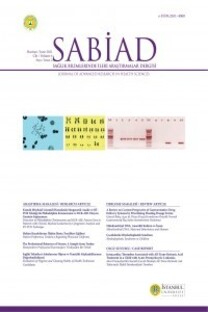İSTATİSTİKTE FREKANSÇI VE BAYESYEN YAKLAŞIMIN ÖRNEKLEM BÜYÜKLÜĞÜ ÜZERİNDEKİ ETKİLERİNİN KARŞILAŞTIRILMASI: METODOLOJİK ÇALIŞMA
Frekantist, bayesyen, örneklem büyüklüğü
COMPARISON OF FREQUENTIST AND BAYESIAN APPROACHES ON SAMPLE SIZE: METHODOLOGIC STUDY
Frequentist, bayesian, sample size,
___
- Rindskopf D. Overview of Bayesian statistics. Eval Rev 2020;44(4):225-37. google scholar
- Beerenwinkel N, Siesbourg J. Probability, statistics, and computational science methods. Methods Mol Biol 2019;1910:33-70. google scholar
- 3. Sami W, Alrukban MO, Waqas T, Asad MR, Afzal K. Sample size determination in health research. J Ayub Med Coll Abbottabad 2018;30(2):308-11 google scholar
- Sacco W. Statistical power considerations in the use of cost-effectiveness analysis. Professional Psychology 1982;13(5):752-8. google scholar
- Mazen AM, Graf LA, Kellog KE, Hemmasi M. Statistical power in contemporary management research. The Academy of Management Journal 1987;30(2):369-80. google scholar
- Kim HY. Statistical notes for clinical researcher: Type I and type II errors in statistical decision. Restor Dent Endod 2015;40(3):249-52. google scholar
- Mozaffarian D, Benjamin E, Go A, Arnett DK, Blaha MJ, Cushman M, et al. Heart disease and stroke statistics-2016 update. A report from the American Heart Association. Circulation 2016;133(4):e38-360. google scholar
- Roth GA, Johnson C, Abajobir A, Abd-Allah F, Abera SF, Abyu G, et al. Global, regional, and national burden of cardiovascular diseases for 10 causes, 1990 to 2015. J Am Coll Cardiol 2017;70(1):1-25. google scholar
- Sweetnam PM, Thomas HF, Yarnell JW, Baker IA, Elwood PC. Total and differential leukocyte counts as predictors of ischemic heart disease: The caerphilly and speedwell Studies. Am J Epidemiol 1997;145(5):416-21. google scholar
- Weijenberg MP, Feskens EJ, Kromhout D. White blood cell count and the risk of coronary heart disease and all-cause mortality in elderly men. Arterioscler Thromb Vasc Biol 1996;16(4):499-503. google scholar
- 11Gupta R, Gupta VP, Sarna M. Bhatnagar S, Thanvi J, Sharma V, et al. Prevalence of coronary heart disease and coronary risk factors in urban Indian population: Jaipur Heart Watch -2. Indian Heart J 2002;54(1):59-66. google scholar
- anjith MP, Divya R, Metha VK, Krishnan MG, KamalRaj R, Kavishwar A. Significance of platelet volume indices and platelet count in ischaemic heart disease. J Clin Pathol 2009;62(9):830- 3. google scholar
- Pizzulli L, Yang A, Martin JF, Lüderitz B. Changes in platelet size and count in unstable angina compared to stable angina or non-cardiac chest pain. Eur Heart J 1998;19(1):80-4. google scholar
- Houghton DE, Koh I, Ellis A, Key NS, Douce DR, Howard G, et al. Hemoglobin levels and coronary heart disease risk by age, race, and sex in the reasons for geographic and racial differences in stroke study (REGARDS). Am J Hematol 2020;95(3):258-6. google scholar
- Stefan AM, Gronau QF, Schönbrodt FD, Wagenmakers EJ. A tutorial on Bayes Factor Design Analysis using an informed prior. Behav Res Methods 2019;51(3):1042-58 google scholar
- Biau DJ, Jolles BM, Porcher R. P value and the theory of hypothesis testing: an explanation for new researchers. Clin Orthop Relat Res 2010;468(3):885-92 google scholar
- Pernet C. Null hypothesis significance testing: a short tutorial. F1000Res 2015;4:621. google scholar
- Greenland S, Senn SJ, Rothman KJ, Carlin JB, Poole C, Goodman SN, et al. Statistical tests, P values, confidence intervals, and power: a guide to misinterpretations Eur J Epidemiol 2016;31(4):337-50. google scholar
- Domenech RJ. The uncertainties of statistical "significance" Rev Med Chil 2018;146(10):1184-9. google scholar
- Morey RD, Romeijn JW, Rouder JN. The philosophy of Bayes factors and the quantification of statistical evidence. J Math Psychol 2016;72:6-18. google scholar
- Kelter R. Analysis of type I and II error rates of Bayesian and frequentist parametric and nonparametric two-sample hypothesis tests under preliminary assessment of normality. Computational Statistics 2021;36:1263-88. google scholar
- Kelter R. Power analysis and type I and type II error rates of Bayesian nonparametric two-sample tests for location-shifts based on the Bayes factor under Cauchy priors. Computational Statistics Data Analysis 2022;165(21):107326. google scholar
- Yayın Aralığı: Yılda 3 Sayı
- Başlangıç: 2018
- Yayıncı: İstanbul Üniversitesi
Ayşe EROL, Figen ABATAY SEL, Mediha SÜLEYMANOĞLU, Gökhan DEMİRAYAK, Dürdane Serap KURUCA, Fatma Savran OĞUZ
Beliz GÜRAY, Hülya ÇAKIR KARABAŞ, Sevde GÖKSEL, Sedef Ayşe TAŞYAPAN, İlknur ÖZCAN
Cennet YILDIZ, Eray YURTSEVEN, Nihan TURHAN, Mehmet Güven GÜNVER
Sevde GÖKSEL, Ahmet Faruk ERTURK, Gulsevim ODA, Hülya ÇAKIR KARABAŞ, İlknur ÖZCAN
Arzu MORÇİÇEK, Ali ÇEKİCİ, Vakur OLGAÇ
TÜRK POPÜLASYONUNDA APE1 ASP148GLU GEN POLİMORFİZMİNİN MESANE KANSERİ İLE İLİŞKİSİ BULUNMAMAKTADIR
Taghı AHMADI RENDI, Serhat KILINÇ, Selçuk ERDEM, Mehmet Enes DEĞİRMENCİ, Öner ŞANLI, Canan KUCUKGERGİN, Semra DOGRU ABBASOGLU
Emre Sertaç BİNGÜL, Emıne Aysu SALVIZ, Mert CANBAZ, Mehmet GÜZEL, Erol KOZANOĞLU, Meltem KARADENİZ
FARKLI RESTORASYON MATERYALLERİNİN EĞİLME DAYANIMLARININ KARŞILAŞTIRILMASI
Almira Ada DİKEN TÜRKSAYAR, Simge BAYTUR
POSTERİOR REVERSİBL ENSEFALOPATİ SENDROMU (PRES) HAKKINDA BİLDİKLERİMİZ DOĞRU MU?
Özlem KARABAY AKGÜL, Erhan OKUYAN, Evrim Ebru KOVALAK, Güzide Ece AKINCI, Mehmet Salih SEVDİ, Hakan GÜRASLAN, Nurşen KURTOĞLU AKSOY, Neşe HAYIRLIOĞLU
